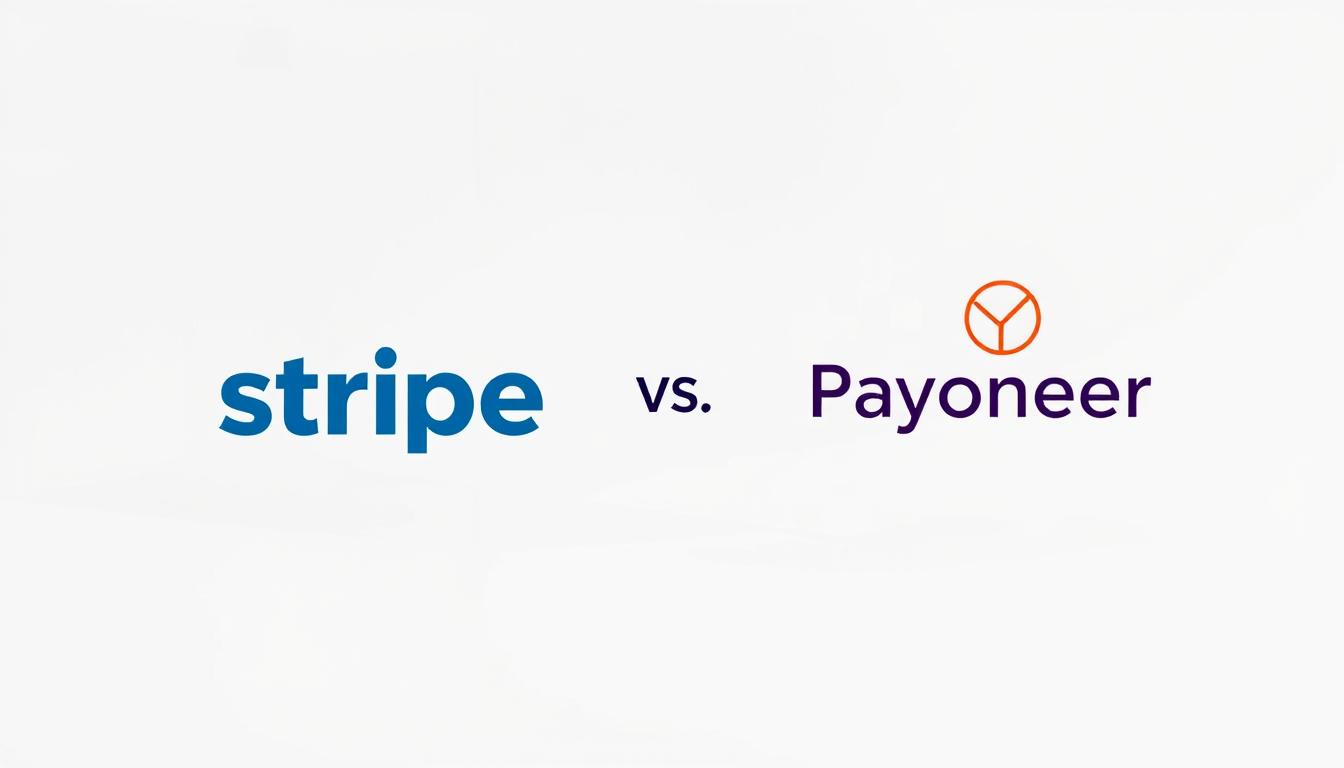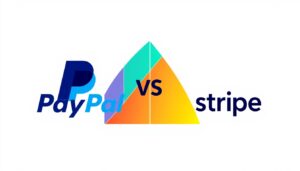“The future of commerce is global, and the tools we use must reflect that.” – Satya Nadella. In today’s interconnected world, businesses are no longer confined by borders. Non-bank payment providers now handle 24% of SMB payment flows, making them essential for seamless global transactions.
For Indian businesses managing cross-border payments, choosing the right platform is critical. This article dives into a detailed comparison of two leading solutions, focusing on features, fees, and regional compliance. Whether you’re a startup or an established enterprise, understanding these platforms can help you make informed decisions.
We’ll also explore alternatives like Karbon, Wise Business, and Skydo, ensuring you have a comprehensive view of your options. Let’s begin this journey to empower your business with the right tools for international success.
Key Takeaways
- Non-bank payment providers handle 24% of SMB payment flows globally.
- Two leading platforms are compared for features, fees, and compliance.
- Indian businesses managing cross-border payments are the target audience.
- Alternatives like Karbon, Wise Business, and Skydo are also discussed.
- Understanding these tools can enhance global transaction efficiency.
Introduction to Stripe and Payoneer
In the fast-paced world of global commerce, selecting the right payment platform can make or break a business. Non-bank providers now handle 24% of SMB payment flows, making them indispensable for modern payment processing. Two leading solutions, Stripe and Payoneer, stand out for their unique strengths and global reach.
Stripe is widely recognized as a developer-friendly platform, ideal for SaaS and e-commerce businesses. Its robust API and integration capabilities make it a top choice for companies looking to streamline their payment systems. On the other hand, Payoneer specializes in serving freelancers and marketplaces, offering tailored solutions for international payments and mass payouts.
When it comes to global transaction capabilities, Stripe supports over 135 currencies, while Payoneer extends its reach to more than 150. This makes both platforms highly versatile for businesses operating across borders. A key differentiator lies in their core offerings: Stripe excels in subscription billing, while Payoneer is renowned for its mass payout features.
For those seeking alternatives, Wise Business’ BatchTransfer feature is worth considering for bulk international payments. Whether you’re a startup or an established enterprise, understanding these platforms’ strengths can help you choose the right tool for your needs.
Key Features of Stripe
In the realm of global payments, Stripe stands out as a versatile solution for businesses of all sizes. Its advanced tools and flexible features cater to diverse needs, making it a top choice for modern payment processing.
Subscription and Recurring Billing
Stripe excels in subscription management, offering tools tailored for SaaS businesses. Its recurring billing system automates payments, ensuring seamless transactions for both businesses and customers. This feature is particularly beneficial for companies with subscription-based models.
Integration and API Capabilities
With over 450 third-party integrations, Stripe seamlessly connects with platforms like Shopify and WooCommerce. Its developer-friendly API allows businesses to customize their payment systems, enhancing flexibility and efficiency.
Supported Payment Methods
Stripe supports a wide range of payment methods, including credit and debit cards (Visa, Mastercard) and digital wallets like Apple Pay and Google Pay. It also offers instant payment links and embedded checkout customization for a smooth user experience.
However, businesses in India should note that Stripe operates on an invite-only basis and currently supports card-only payments. This limitation may affect its suitability for certain use cases.
- Automated subscription billing for SaaS businesses.
- 450+ third-party integrations, including Shopify and WooCommerce.
- Supports credit/debit cards and digital wallets.
- Instant payment links and customizable checkout options.
- India-specific limitations: Invite-only access, card-only payments.
Key Features of Payoneer
Payoneer has become a trusted name for freelancers and enterprises managing global transactions. Its platform is designed to simplify cross-border payments, offering tools that cater to diverse business needs. Whether you’re a freelancer, marketplace seller, or exporter, Payoneer provides solutions to streamline your financial operations.
Freelancer and Marketplace Focus
Payoneer excels in serving freelancers and marketplaces. It integrates with over 2,000 platforms, including Amazon, Upwork, and Fiverr. This makes it easy for users to receive payments directly into their Payoneer accounts. Virtual accounts for US, UK, EU, and AU receivables further simplify the process, reducing delays and fees.
Multi-Currency Support
With support for multiple currencies, Payoneer enables businesses to transact globally without hassle. Currency conversion fees are competitive, typically up to 3%. This feature is particularly beneficial for Indian exporters who need to manage transactions in various currencies.
Mass Payouts and API Support
For enterprises, Payoneer offers API-driven mass payouts, allowing businesses to pay multiple recipients simultaneously. Multi-user access ensures efficient team collaboration. Additionally, Payoneer’s FIRA compliance provides a significant advantage for Indian exporters, simplifying documentation and compliance processes.
- Virtual accounts for US, UK, EU, and AU receivables.
- Seamless integrations with Amazon, Upwork, and Fiverr.
- Competitive currency conversion fees (up to 3%).
- API-driven mass payouts for enterprise needs.
- FIRA compliance for Indian exporters.
Stripe vs Payoneer: Account Setup and Fees
Understanding the setup process and fee structures is essential for businesses managing international payments. Both platforms offer distinct approaches, catering to different needs and preferences.
Account Setup Process
Setting up an account varies significantly between the two platforms. One operates on an invite-only basis in India, requiring businesses to apply and wait for approval. This model ensures a curated user base but may delay onboarding. In contrast, the other offers open registration, allowing users to sign up quickly and start transacting immediately.
Transaction Fees Comparison
When it comes to transaction fees, the differences are notable. For domestic card processing, one platform charges a fixed rate plus a percentage, while international transactions incur additional costs. The other platform offers competitive rates for mass payouts, making it ideal for businesses with high-volume transactions.
- Domestic card processing: Fixed rate + percentage.
- International transactions: Additional fees apply.
- Mass payouts: Competitive rates for high-volume users.
Currency Conversion Fees
Currency conversion is another critical factor. One platform charges a 1% markup, while the other imposes a 3% fee. For example, a ₹10,000 transaction would cost ₹10,100 on the first platform and ₹10,300 on the second. These differences can significantly impact overall costs for businesses dealing with multiple currencies.
- Platform A: 1% markup on currency conversion.
- Platform B: 3% markup on currency conversion.
- Example: ₹10,000 transaction costs ₹10,100 vs. ₹10,300.
Hidden costs, such as chargeback fees ($15 on both platforms) and prepaid card charges, should also be considered. Evaluating these factors helps businesses choose the most cost-effective solution for their needs.
Supported Currencies and Global Reach
Global businesses require platforms that support diverse currencies and seamless transactions across borders. Understanding the regional strengths and capabilities of these platforms is essential for making informed decisions.
One platform excels in North America, offering robust support for businesses in the region. The other focuses on emerging markets, providing tailored solutions for international payments in areas like Asia and Africa. This regional specialization influences their suitability for different business needs.
Both platforms support major currencies such as USD, EUR, GBP, AUD, and CAD. For Indian businesses, this is particularly beneficial when receiving payments in AED or SGD. The ability to hold multiple currencies in virtual accounts further simplifies transactions, reducing the need for frequent conversions.
For unsupported currencies, SWIFT transfer options are available. This ensures businesses can still process payments, albeit with additional fees. Comparing these features helps businesses choose the right platform for their international payments needs.
- Regional coverage: North America vs. emerging markets focus.
- Key supported currencies: USD, EUR, GBP, AUD, CAD.
- Implications for Indian businesses receiving AED/SGD payments.
- Currency holding capabilities in virtual accounts.
- SWIFT transfer options for unsupported currencies.
Payment Methods: Stripe vs Payoneer
When it comes to managing global transactions, the choice of payment methods can significantly impact business efficiency. Both platforms offer distinct options, catering to diverse needs and preferences. Understanding these differences is crucial for businesses aiming to optimize their payment processes.
Credit and Debit Cards
One platform supports a wide range of cards, including Visa, Mastercard, and American Express. This broad acceptance ensures flexibility for businesses and customers alike. However, Diners Club coverage is limited, which may affect certain users.
The other platform focuses on seamless card transactions, offering competitive rates for both domestic and international payments. This makes it a reliable choice for businesses with high-volume card transactions.
Bank Transfers and Digital Wallets
For businesses relying on bank transfers, one platform provides ACH capabilities, particularly beneficial for US-based transactions. This feature simplifies payments and reduces processing times.
Digital wallet support varies between the platforms. One integrates with PayPal, while the other offers native solutions for a smoother user experience. Notably, UPI integration is absent in both, which may limit options for Indian businesses.
Buy Now, Pay Later (BNPL) Options
One platform stands out with its BNPL feature, charging 5.99% + 30¢ per transaction. This option is gaining traction in key markets like the US, EU, and AU, offering flexibility for customers.
The other platform, however, is limited to traditional bank transfers and cards, which may restrict its appeal for businesses seeking innovative payment solutions.
- Compare card network acceptance: Amex/Diners Club coverage.
- Analyze BNPL adoption rates in key markets (US, EU, AU).
- Discuss UPI integration absence in both platforms.
- Evaluate digital wallet support: PayPal vs native solutions.
- Highlight ACH capabilities for US-based transactions.
Payout Speed and Flexibility
Efficient payout speeds are crucial for businesses relying on timely transfers. Whether you’re a freelancer or an enterprise, the ability to access funds quickly can make a significant difference in cash flow management. This section explores the payout timelines and flexibility offered by leading platforms, helping you choose the right solution for your needs.
Standard Payout Times
Standard payout times vary between platforms. One option offers a 2-day processing period, ensuring funds reach your account swiftly. In contrast, the other takes 2-5 business days, which may delay access to funds. For Indian businesses, INR settlements to local banks can take an additional day, depending on the platform.
Instant Payout Options
For urgent needs, instant payouts are available at a 1% fee. This feature is ideal for businesses requiring immediate access to funds. However, it’s essential to weigh the cost-benefit, as frequent use can add up over time. Withdrawal limits also play a role, with minimum and maximum transaction amounts varying by platform.
- Compare processing times for INR settlements to Indian banks.
- Discuss weekend and holiday impacts on transfer timelines.
- Analyze the cost-benefit of instant payouts for cash flow management.
- Detail withdrawal limits: Minimum and maximum transaction amounts.
- Case study: A freelancer receiving a $5,000 payment experiences different timelines.
For example, a freelancer receiving a $5,000 payment may access funds in 2 days with one platform or wait up to 5 days with another. Understanding these differences helps businesses plan their financial operations effectively.
Security and Fraud Detection
Ensuring secure transactions is a top priority for businesses handling global payments. Both platforms offer robust security measures to protect users from fraud and unauthorized access. Understanding these features can help businesses choose the right solution for their needs.
Both platforms are PCI DSS compliant, ensuring that sensitive payment data is handled securely. This certification is essential for businesses that process credit card transactions. Additionally, they use advanced machine learning algorithms to detect and prevent fraudulent activities in real-time.
Two-factor authentication (2FA) is another critical feature. It adds an extra layer of security by requiring users to verify their identity through a second method, such as a text message or authentication app. Encryption standards further protect data during transmission and storage.
Chargeback management is also a key consideration. Both platforms charge a $15 fee for chargebacks, but one offers dispute management tools to help businesses resolve issues efficiently. This is particularly useful for e-commerce businesses, where chargeback ratios tend to be higher compared to freelance sectors.
- Compare PCI compliance certifications for secure payment processing.
- Analyze machine learning fraud detection systems for real-time protection.
- Discuss 2FA implementation and encryption standards for enhanced security.
- Evaluate chargeback ratios in e-commerce vs freelance sectors.
- Highlight transaction verification protocols for added safety.
By prioritizing security and fraud detection, businesses can minimize risks and build trust with their customers. These features are essential for maintaining a secure payment processing environment.
Customer Support and Accessibility
Reliable customer support is a cornerstone of any payment platform, especially for businesses operating in diverse markets like India. Efficient and accessible assistance ensures smooth operations and builds trust among users. This section explores the support channels and accessibility features of leading platforms, helping you make an informed choice.
Support Channels
One platform offers comprehensive support through email, chat, and phone, ensuring users can reach out through their preferred method. This multi-channel approach caters to diverse needs, making it easier to resolve issues quickly. In contrast, another platform provides 24/7 support but lacks a local team in India, which may affect response times for Indian users.
Availability in India
For Indian businesses, localized support is crucial. One platform stands out with its Hindi support availability, making it more accessible to a wider audience. However, the absence of a local team in India for the other platform may limit its effectiveness in addressing region-specific concerns.
- Compare response times: 24/7 support vs business hours.
- Evaluate localization: Hindi support availability.
- Discuss escalation protocols for disputed transactions.
- Analyze self-service resources: Knowledge bases vs video tutorials.
- Mention Skydo’s India-based support as an alternative advantage.
For those seeking alternatives, Skydo offers India-based support, providing a significant advantage for local businesses. This ensures faster resolution of issues and better alignment with regional needs. Understanding these differences helps businesses choose the right platform for their support requirements.
Integration with E-commerce Platforms
Seamless integration with e-commerce platforms is a game-changer for modern businesses. The ability to connect with diverse systems enhances operational efficiency and ensures smooth payment processing. Whether you’re a developer or a marketplace seller, understanding the integration capabilities of these platforms is essential.
Developer-Friendly Tools
One platform stands out with its robust developer tools, including a React.js library for custom checkout flows. This allows businesses to create tailored payment experiences that align with their brand. The platform also offers comprehensive API documentation and SDK availability, making it easier for developers to implement and customize solutions.
Webhook configurations further enhance the experience by enabling real-time payment notifications. This ensures that businesses stay updated on transaction statuses without manual checks. Additionally, middleware solutions like Zapier compatibility simplify integration with other tools, streamlining workflows.
Marketplace Integrations
Another platform excels in connecting with over 2,000 marketplaces, including giants like Airbnb, Amazon, and Walmart. This makes it a preferred choice for freelancers and sellers who rely on these platforms for their income. The seamless integration ensures that payments are processed efficiently, reducing delays and improving cash flow.
- React.js library for custom checkout flows.
- Comprehensive API documentation and SDK availability.
- Webhook configurations for real-time notifications.
- Zapier compatibility for middleware integration.
- Top marketplace integrations: Airbnb, Amazon, Walmart.
By leveraging these integration tools, businesses can optimize their payment processes and focus on growth. The right platform can make all the difference in achieving global success.
Stripe vs Payoneer: Best Use Cases
Choosing the right payment platform depends on your business type and goals. Whether you’re a freelancer, a SaaS company, or an e-commerce business, understanding the strengths of each platform can help you make an informed decision.
Freelancers and Contractors
For freelancers earning less than $2,000 monthly, one platform stands out. It simplifies onboarding with minimal KYC documentation, making it ideal for independent professionals. Virtual accounts for US, UK, EU, and AU receivables reduce delays and fees, ensuring timely payments.
This platform also integrates with over 2,000 marketplaces, including Upwork and Fiverr. This makes it a preferred choice for freelancers who rely on these platforms for their income. Additionally, competitive currency conversion fees (up to 3%) make it cost-effective for global transactions.
E-commerce and SaaS Businesses
Scaling SaaS companies often benefit from the other platform’s robust API and subscription management tools. Its recurring billing system automates payments, ensuring seamless transactions for both businesses and their clients. With over 450 third-party integrations, it seamlessly connects with platforms like Shopify and WooCommerce.
For e-commerce businesses, the platform supports a wide range of payment methods, including credit cards and digital wallets. However, Indian users should note its invite-only access and card-only payment limitations. Upgrading to enterprise plans offers scalability for growing businesses.
- Compare onboarding requirements: KYC documentation needs.
- Analyze payment volume thresholds for cost efficiency.
- Discuss industry-specific advantages: IT services vs physical goods.
- Present growth scalability: Upgrading to enterprise plans.
- Mention Karbon’s tailored solutions for Indian tech startups.
For Indian tech startups, Karbon offers tailored solutions that align with local needs. Its FIRA compliance and competitive fees make it a strong alternative for businesses managing cross-border payments. Understanding these options ensures you choose the right platform for your unique requirements.
Pricing Comparison: Stripe vs Payoneer
Understanding the cost structure of payment platforms is vital for businesses aiming to optimize expenses. A detailed analysis of pricing, fees, and hidden costs can help businesses choose the most cost-effective solution for their needs.
Transaction Fees
When it comes to transaction costs, the differences are significant. One platform charges 4.3% + 2% for domestic card payments in India, while international transactions incur additional fees. The other platform imposes a 3% forex markup, along with a 1-3.2% fee and a $0.49 flat charge per transaction.
For businesses with a ₹50L turnover, these differences can translate into substantial annual cost variations. It’s essential to evaluate these fees based on your transaction volume and business model.
Withdrawal Fees
Withdrawal costs also vary between platforms. One charges a flat fee for bank transfers, while the other imposes a percentage-based fee. For Indian businesses, INR withdrawals to local banks may incur additional charges, depending on the platform.
Hidden Costs
Hidden fees can significantly impact overall expenses. Charges for inactive accounts, statement requests, and chargebacks ($15 on both platforms) should be considered. For example, a ₹10,000 transaction could cost ₹10,300 on one platform due to currency conversion fees.
- Tabulate side-by-side fee comparison for common scenarios.
- Expose hidden fees: Inactive account charges, statement requests.
- Calculate annual cost differences for ₹50L turnover businesses.
- Discuss fee negotiation possibilities for high-volume users.
- Compare Wise Business’ mid-market rate advantage.
For high-volume users, fee negotiation is possible on some platforms, offering potential savings. Additionally, alternatives like Wise Business provide mid-market rates, which can be more cost-effective for businesses dealing with multiple currencies.
Compliance and FIRA in India
Navigating regulatory requirements is a critical aspect for companies operating in India. The Reserve Bank of India (RBI) mandates specific guidelines for cross-border transactions, ensuring transparency and accountability. One such requirement is the Foreign Inward Remittance Advice (FIRA), which serves as proof of international payments received by Indian businesses.
Understanding these regulations is essential for businesses to avoid penalties and ensure smooth operations. Both payment platforms offer solutions to meet these requirements, but their approaches differ significantly.
Stripe’s Compliance in India
For businesses using this platform, obtaining FIRA involves a bank-assisted process. This means that users must coordinate with their banks to generate the necessary documentation. While this method is reliable, it can be time-consuming and may delay the issuance of FIRA certificates.
Additionally, the platform requires GST-compliant invoices for transactions. This ensures that businesses adhere to Indian tax regulations, but it also adds an extra layer of documentation. The turnaround time for export realization certificates can vary, depending on the bank’s efficiency.
Payoneer’s FIRA Offering
In contrast, this platform provides a free digital FIRA service, simplifying the process for users. Businesses can generate FIRA certificates directly from their accounts, eliminating the need for bank involvement. This feature is particularly beneficial for freelancers and small businesses that require quick access to documentation.
However, users must still ensure that their invoices are GST-compliant. The platform’s streamlined approach reduces the turnaround time for export realization certificates, making it a preferred choice for many Indian businesses.
- Explain FIRA requirements under RBI guidelines.
- Detail documentation process for GST-compliant invoices.
- Analyze turnaround time for export realization certificates.
- Discuss implications of non-compliance for MSMEs.
- Highlight Skydo’s RBI-approved PA-CB status.
For MSMEs, non-compliance with FIRA requirements can lead to penalties and operational disruptions. Platforms like Skydo, with their RBI-approved PA-CB status, offer an alternative for businesses seeking streamlined compliance solutions. Understanding these options ensures that companies can choose the right platform for their needs.
Pros and Cons of Stripe
When evaluating payment platforms, understanding their strengths and weaknesses is crucial for businesses. One platform offers a range of features tailored for modern needs, but it also comes with certain limitations.
One of its key strengths is its recurring billing system, which automates payments for subscription-based businesses. This feature ensures seamless transactions and enhances cash flow management. Additionally, its unified global payouts simplify transactions across borders, making it a versatile choice for international businesses.
However, there are notable drawbacks. For Indian users, the platform operates on an invite-only basis, which can delay onboarding. It also lacks support for FIRA, a critical requirement for cross-border transactions in India. Furthermore, its credit card-only payment method limits flexibility for businesses that rely on other payment options.
For developers, the platform offers advanced tools like webhooks and Stripe.js customization. These features enable businesses to create tailored payment experiences. However, recent RBI regulations have added complexity for Indian users, requiring additional compliance measures.
- Strengths: Recurring billing, unified global payouts.
- Weaknesses: No FIRA, limited India payment methods.
- Developer advantages: Webhooks, Stripe.js customization.
- RBI regulation impacts: Increased compliance requirements.
- Comparison: Karbon’s India-first approach offers streamlined solutions.
For businesses seeking alternatives, Karbon’s India-first approach provides a strong option. Its focus on local compliance and competitive fees makes it a viable choice for managing cross-border payments. Understanding these pros and cons ensures businesses can make informed decisions.
Pros and Cons of Payoneer
Evaluating the strengths and weaknesses of a payment platform is essential for businesses aiming to optimize their financial operations. Payoneer offers a range of features designed to simplify global transactions, but it also comes with certain limitations.
One of Payoneer’s standout advantages is its free FIRA service, which simplifies compliance for Indian businesses receiving international payments. This feature eliminates the need for bank-assisted documentation, saving time and effort. Additionally, its mass payout capabilities make it ideal for enterprises managing high-volume transactions.
Payoneer also supports multi-currency accounts, allowing businesses to hold and transact in multiple currencies. Its extensive marketplace network, including integrations with Amazon and Upwork, ensures seamless payment processing for freelancers and sellers.
However, there are notable drawbacks. The platform charges a 3% forex markup, which can add up for businesses dealing with frequent currency conversions. Its prepaid Mastercard, while useful for frequent travelers, comes with a $29.95 annual fee. High inactive account fees and slow withdrawal times further limit its appeal for some users.
- Advantages: Free FIRA, mass payouts, multi-currency accounts, marketplace network.
- Drawbacks: 3% forex markup, $29.95 card fee, high inactive account fees, slow withdrawals.
Customer service challenges have also been noted in user reviews, with some users reporting delayed responses. For businesses seeking alternatives, Wise Business offers competitive currency hedging options, making it a viable choice for managing international payments.
By understanding these pros and cons, businesses can determine whether Payoneer aligns with their needs or if an alternative solution would be more suitable.
Alternative Payment Solutions
Exploring alternative payment solutions can open new doors for businesses managing global transactions. While established platforms offer robust features, emerging solutions like Wise Business and Skydo provide unique advantages tailored to specific needs. These alternatives are particularly beneficial for Indian companies seeking cost-effective and efficient ways to handle international payments.
Wise Business
Wise Business stands out with its mid-market rates, ensuring businesses get the best value for currency conversions. Its BatchTransfer feature is ideal for bulk international payments, allowing companies to send funds to multiple recipients simultaneously. This is especially useful for businesses with high-volume transactions, as it reduces both time and costs.
Additionally, Wise offers transparent pricing with no hidden fees. Its user-friendly interface and detailed transaction tracking make it a preferred choice for businesses looking to streamline their transfer processes. For Indian exporters, Wise’s competitive rates can significantly reduce overhead costs.
Skydo
Skydo is another strong contender, offering 0.3% fees for transactions above $10,000. Its 24-48 hour settlement times ensure quick access to funds, which is crucial for businesses managing cash flow. Skydo’s RBI approval adds an extra layer of trust, making it a reliable option for Indian companies.
Skydo also provides a seamless onboarding process, with minimal documentation required. Its focus on compliance and transparency makes it an attractive alternative for businesses looking to avoid the complexities of traditional payment platforms.
- Wise Business: Mid-market rates, BatchTransfer for bulk payments, transparent pricing.
- Skydo: 0.3% fees for high-value transactions, 24-48 hour settlements, RBI approval.
- Both platforms offer competitive advantages for Indian exporters and businesses managing global transactions.
When comparing these alternatives to incumbents, it’s clear that they offer unique benefits tailored to specific business needs. Whether it’s Wise’s mid-market rates or Skydo’s rapid settlements, these platforms provide viable options for businesses looking to optimize their international payments.
Conclusion: Stripe vs Payoneer – Which is Right for You?
Selecting the right payment solution is pivotal for businesses aiming to streamline global transactions. To make informed decisions, consider factors like transaction volume, supported payment methods, and compliance requirements.
For SaaS and e-commerce businesses with technical resources, one platform stands out with its robust API and subscription management tools. Freelancers and marketplace sellers, on the other hand, may find another platform more suitable due to its mass payout capabilities and extensive integrations.
For cost-sensitive international transfers, alternatives like Wise and Skydo offer competitive rates and faster settlements. Additionally, Karbon provides emerging solutions tailored for India-focused businesses, ensuring compliance and efficiency.
Ultimately, the right choice depends on your specific needs and operational goals. Evaluate your priorities to select the platform that aligns best with your business strategy.







